LAWS20059 - Corporation Law: Analyzing Company and Partnership
VerifiedAdded on 2023/06/09
|8
|2775
|178
Report
AI Summary
This report provides a detailed analysis of two key business structures in Australia: partnerships and companies, as governed by the Partnership Act 1891 and the Corporations Act 2001, respectively. It outlines the essential components of each structure, including the legal definitions, liabilities, and operational aspects. The report further compares the advantages and disadvantages of both partnerships and companies, considering factors such as liability, taxation, and ease of ownership transfer. A recommendation is made favoring the company structure for its limited liability and organizational benefits. Additionally, the report examines the duties of company directors under the Corporations Act 2001, using the ASIC v Adler case as a key example to illustrate the responsibilities and obligations of directors towards shareholders and stakeholders, emphasizing the importance of due care and diligence in corporate governance. Desklib provides a platform for students to access similar solved assignments and past papers.
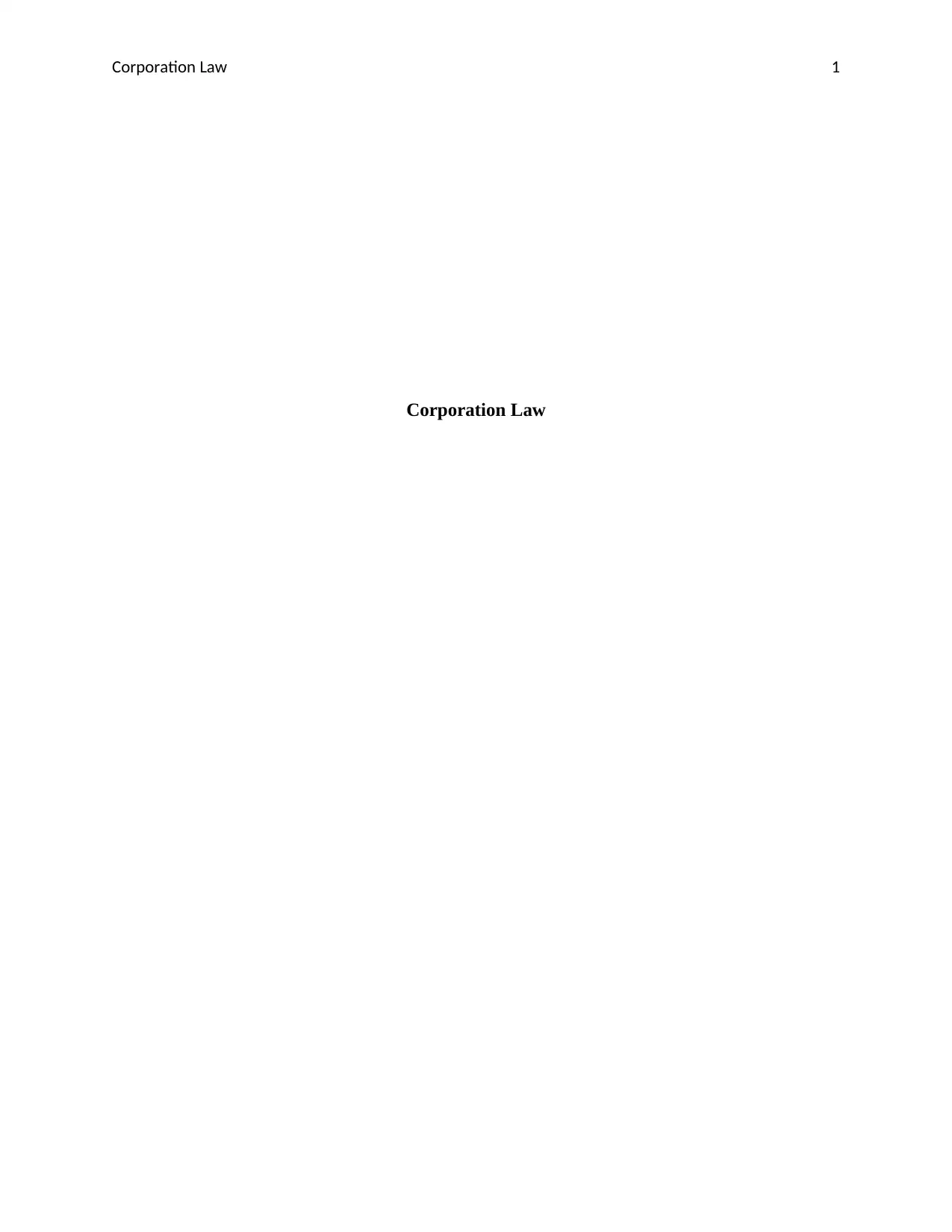
Corporation Law 1
Corporation Law
Corporation Law
Paraphrase This Document
Need a fresh take? Get an instant paraphrase of this document with our AI Paraphraser
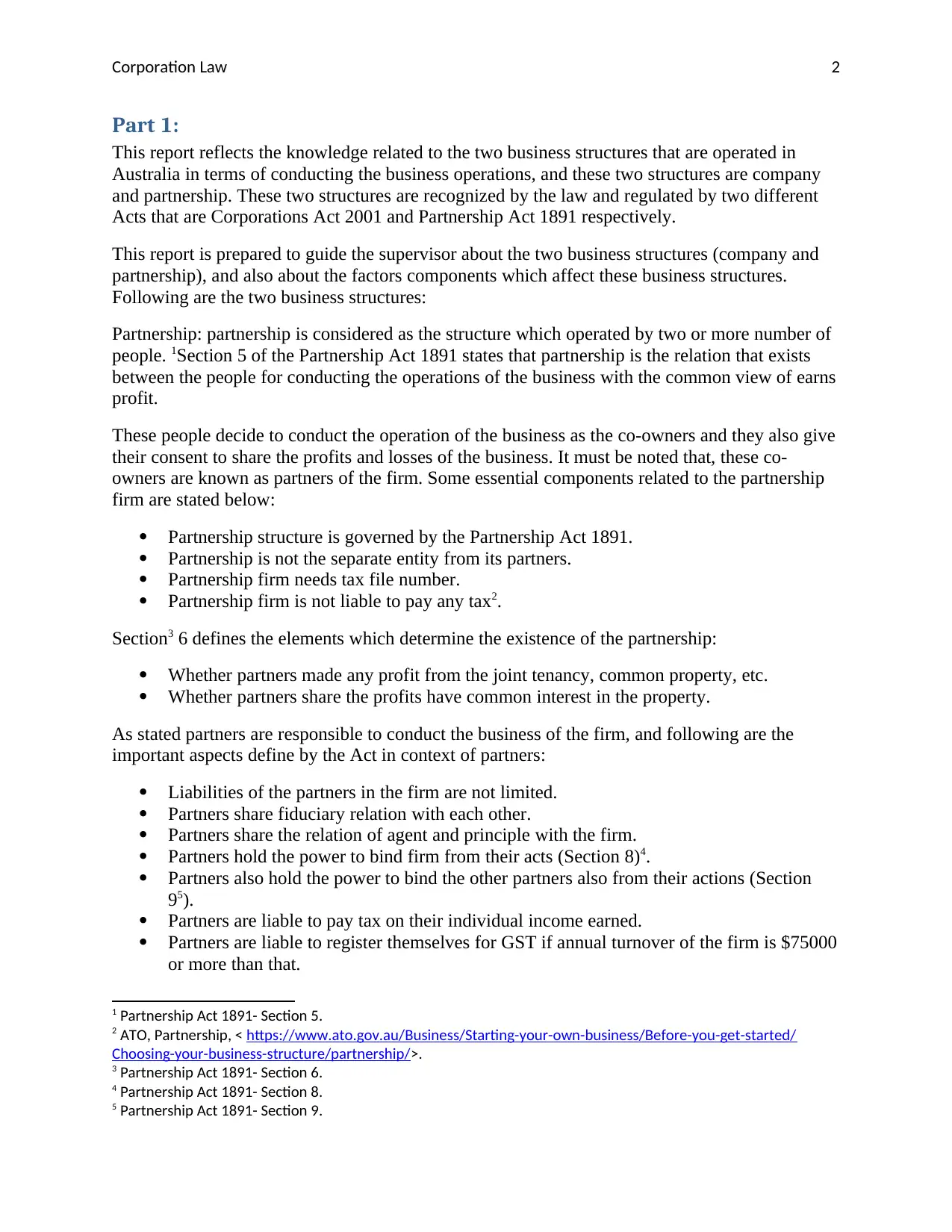
Corporation Law 2
Part 1:
This report reflects the knowledge related to the two business structures that are operated in
Australia in terms of conducting the business operations, and these two structures are company
and partnership. These two structures are recognized by the law and regulated by two different
Acts that are Corporations Act 2001 and Partnership Act 1891 respectively.
This report is prepared to guide the supervisor about the two business structures (company and
partnership), and also about the factors components which affect these business structures.
Following are the two business structures:
Partnership: partnership is considered as the structure which operated by two or more number of
people. 1Section 5 of the Partnership Act 1891 states that partnership is the relation that exists
between the people for conducting the operations of the business with the common view of earns
profit.
These people decide to conduct the operation of the business as the co-owners and they also give
their consent to share the profits and losses of the business. It must be noted that, these co-
owners are known as partners of the firm. Some essential components related to the partnership
firm are stated below:
Partnership structure is governed by the Partnership Act 1891.
Partnership is not the separate entity from its partners.
Partnership firm needs tax file number.
Partnership firm is not liable to pay any tax2.
Section3 6 defines the elements which determine the existence of the partnership:
Whether partners made any profit from the joint tenancy, common property, etc.
Whether partners share the profits have common interest in the property.
As stated partners are responsible to conduct the business of the firm, and following are the
important aspects define by the Act in context of partners:
Liabilities of the partners in the firm are not limited.
Partners share fiduciary relation with each other.
Partners share the relation of agent and principle with the firm.
Partners hold the power to bind firm from their acts (Section 8)4.
Partners also hold the power to bind the other partners also from their actions (Section
95).
Partners are liable to pay tax on their individual income earned.
Partners are liable to register themselves for GST if annual turnover of the firm is $75000
or more than that.
1 Partnership Act 1891- Section 5.
2 ATO, Partnership, < https://www.ato.gov.au/Business/Starting-your-own-business/Before-you-get-started/
Choosing-your-business-structure/partnership/>.
3 Partnership Act 1891- Section 6.
4 Partnership Act 1891- Section 8.
5 Partnership Act 1891- Section 9.
Part 1:
This report reflects the knowledge related to the two business structures that are operated in
Australia in terms of conducting the business operations, and these two structures are company
and partnership. These two structures are recognized by the law and regulated by two different
Acts that are Corporations Act 2001 and Partnership Act 1891 respectively.
This report is prepared to guide the supervisor about the two business structures (company and
partnership), and also about the factors components which affect these business structures.
Following are the two business structures:
Partnership: partnership is considered as the structure which operated by two or more number of
people. 1Section 5 of the Partnership Act 1891 states that partnership is the relation that exists
between the people for conducting the operations of the business with the common view of earns
profit.
These people decide to conduct the operation of the business as the co-owners and they also give
their consent to share the profits and losses of the business. It must be noted that, these co-
owners are known as partners of the firm. Some essential components related to the partnership
firm are stated below:
Partnership structure is governed by the Partnership Act 1891.
Partnership is not the separate entity from its partners.
Partnership firm needs tax file number.
Partnership firm is not liable to pay any tax2.
Section3 6 defines the elements which determine the existence of the partnership:
Whether partners made any profit from the joint tenancy, common property, etc.
Whether partners share the profits have common interest in the property.
As stated partners are responsible to conduct the business of the firm, and following are the
important aspects define by the Act in context of partners:
Liabilities of the partners in the firm are not limited.
Partners share fiduciary relation with each other.
Partners share the relation of agent and principle with the firm.
Partners hold the power to bind firm from their acts (Section 8)4.
Partners also hold the power to bind the other partners also from their actions (Section
95).
Partners are liable to pay tax on their individual income earned.
Partners are liable to register themselves for GST if annual turnover of the firm is $75000
or more than that.
1 Partnership Act 1891- Section 5.
2 ATO, Partnership, < https://www.ato.gov.au/Business/Starting-your-own-business/Before-you-get-started/
Choosing-your-business-structure/partnership/>.
3 Partnership Act 1891- Section 6.
4 Partnership Act 1891- Section 8.
5 Partnership Act 1891- Section 9.

Corporation Law 3
Partnership structure consist two forms that are general partnership and limited partnership. In
general partnership, liability of the partners is not limited but in limited partnership liability of
partners is limited.
Generally, joint venture is considered as partnership but in some particular situation only, and
that situation is defined by Court in case Canny Gabriel Castle Advertising Pty Ltd & Anor v
Volume Sales (Finance) Pty Ltd [1974] HCA 22; (1974) 131 CLR 3216. As per this case, if
partners share profits with each other and these profits were earned from the joint tenancy from
any property or thing then such venture can be considered as partnership.
Company:
On the other hand, company is the business structure which can be adopted by the person at the
initial stage or at the growing stage of the business. Companies do not exist under the common
law, but these entities are created by the law. Section 9 of the Corporations Act 20017 defines the
meaning of the company and as per this section any company which registered under this Act.
This section also states the different types of companies that are company limited by shares,
company limited by guarantee, unlimited liability company, and no liability company8.
Following are the essential elements of the company:
Company is the entity which is separate from its owners, and this means that company is
the legal person which holds the rights to sue and be sued, enter into contracts, own
property, etc. This can be understood through case law Salomon v A Salomon & Co Ltd
[1896] UKHL 1, [1897] AC 229.
Section 124 states that company holds all the rights as the legal person and also includes
the right to issue shares and debentures, and also the perpetual succession.
Owners of the company have benefit of limited liability, which means, shareholders are
not personally liable for debts and losses of the company (Macaura v Northern
Assurance Co Ltd, [1925] AC 61910).
Directors of the company are responsible to manage the operations of the business.
6 Canny Gabriel Castle Advertising Pty Ltd & Anor v Volume Sales (Finance) Pty Ltd [1974] HCA 22; (1974) 131 CLR
321.
7 Corporation Act 2001- section 9.
8 DIIS, Company, (2017), < https://www.business.gov.au/Info/Plan-and-Start/Start-your-business/Business-
structure/Business-structures-and-types/Company>.
9 Salomon v A Salomon & Co Ltd [1896] UKHL 1, [1897] AC 22.
10 Macaura v Northern Assurance Co Ltd, [1925] AC 619
Partnership structure consist two forms that are general partnership and limited partnership. In
general partnership, liability of the partners is not limited but in limited partnership liability of
partners is limited.
Generally, joint venture is considered as partnership but in some particular situation only, and
that situation is defined by Court in case Canny Gabriel Castle Advertising Pty Ltd & Anor v
Volume Sales (Finance) Pty Ltd [1974] HCA 22; (1974) 131 CLR 3216. As per this case, if
partners share profits with each other and these profits were earned from the joint tenancy from
any property or thing then such venture can be considered as partnership.
Company:
On the other hand, company is the business structure which can be adopted by the person at the
initial stage or at the growing stage of the business. Companies do not exist under the common
law, but these entities are created by the law. Section 9 of the Corporations Act 20017 defines the
meaning of the company and as per this section any company which registered under this Act.
This section also states the different types of companies that are company limited by shares,
company limited by guarantee, unlimited liability company, and no liability company8.
Following are the essential elements of the company:
Company is the entity which is separate from its owners, and this means that company is
the legal person which holds the rights to sue and be sued, enter into contracts, own
property, etc. This can be understood through case law Salomon v A Salomon & Co Ltd
[1896] UKHL 1, [1897] AC 229.
Section 124 states that company holds all the rights as the legal person and also includes
the right to issue shares and debentures, and also the perpetual succession.
Owners of the company have benefit of limited liability, which means, shareholders are
not personally liable for debts and losses of the company (Macaura v Northern
Assurance Co Ltd, [1925] AC 61910).
Directors of the company are responsible to manage the operations of the business.
6 Canny Gabriel Castle Advertising Pty Ltd & Anor v Volume Sales (Finance) Pty Ltd [1974] HCA 22; (1974) 131 CLR
321.
7 Corporation Act 2001- section 9.
8 DIIS, Company, (2017), < https://www.business.gov.au/Info/Plan-and-Start/Start-your-business/Business-
structure/Business-structures-and-types/Company>.
9 Salomon v A Salomon & Co Ltd [1896] UKHL 1, [1897] AC 22.
10 Macaura v Northern Assurance Co Ltd, [1925] AC 619
⊘ This is a preview!⊘
Do you want full access?
Subscribe today to unlock all pages.

Trusted by 1+ million students worldwide
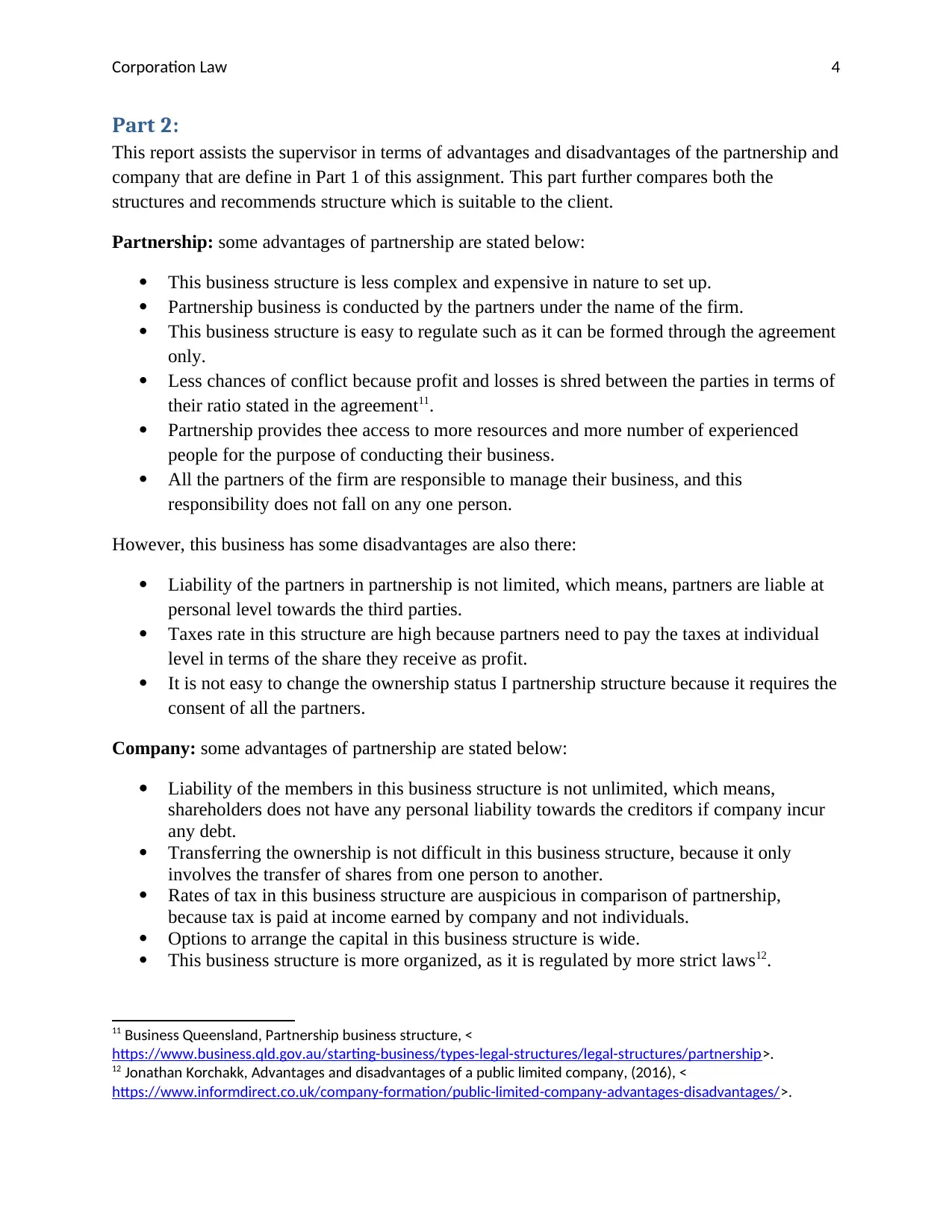
Corporation Law 4
Part 2:
This report assists the supervisor in terms of advantages and disadvantages of the partnership and
company that are define in Part 1 of this assignment. This part further compares both the
structures and recommends structure which is suitable to the client.
Partnership: some advantages of partnership are stated below:
This business structure is less complex and expensive in nature to set up.
Partnership business is conducted by the partners under the name of the firm.
This business structure is easy to regulate such as it can be formed through the agreement
only.
Less chances of conflict because profit and losses is shred between the parties in terms of
their ratio stated in the agreement11.
Partnership provides thee access to more resources and more number of experienced
people for the purpose of conducting their business.
All the partners of the firm are responsible to manage their business, and this
responsibility does not fall on any one person.
However, this business has some disadvantages are also there:
Liability of the partners in partnership is not limited, which means, partners are liable at
personal level towards the third parties.
Taxes rate in this structure are high because partners need to pay the taxes at individual
level in terms of the share they receive as profit.
It is not easy to change the ownership status I partnership structure because it requires the
consent of all the partners.
Company: some advantages of partnership are stated below:
Liability of the members in this business structure is not unlimited, which means,
shareholders does not have any personal liability towards the creditors if company incur
any debt.
Transferring the ownership is not difficult in this business structure, because it only
involves the transfer of shares from one person to another.
Rates of tax in this business structure are auspicious in comparison of partnership,
because tax is paid at income earned by company and not individuals.
Options to arrange the capital in this business structure is wide.
This business structure is more organized, as it is regulated by more strict laws12.
11 Business Queensland, Partnership business structure, <
https://www.business.qld.gov.au/starting-business/types-legal-structures/legal-structures/partnership>.
12 Jonathan Korchakk, Advantages and disadvantages of a public limited company, (2016), <
https://www.informdirect.co.uk/company-formation/public-limited-company-advantages-disadvantages/>.
Part 2:
This report assists the supervisor in terms of advantages and disadvantages of the partnership and
company that are define in Part 1 of this assignment. This part further compares both the
structures and recommends structure which is suitable to the client.
Partnership: some advantages of partnership are stated below:
This business structure is less complex and expensive in nature to set up.
Partnership business is conducted by the partners under the name of the firm.
This business structure is easy to regulate such as it can be formed through the agreement
only.
Less chances of conflict because profit and losses is shred between the parties in terms of
their ratio stated in the agreement11.
Partnership provides thee access to more resources and more number of experienced
people for the purpose of conducting their business.
All the partners of the firm are responsible to manage their business, and this
responsibility does not fall on any one person.
However, this business has some disadvantages are also there:
Liability of the partners in partnership is not limited, which means, partners are liable at
personal level towards the third parties.
Taxes rate in this structure are high because partners need to pay the taxes at individual
level in terms of the share they receive as profit.
It is not easy to change the ownership status I partnership structure because it requires the
consent of all the partners.
Company: some advantages of partnership are stated below:
Liability of the members in this business structure is not unlimited, which means,
shareholders does not have any personal liability towards the creditors if company incur
any debt.
Transferring the ownership is not difficult in this business structure, because it only
involves the transfer of shares from one person to another.
Rates of tax in this business structure are auspicious in comparison of partnership,
because tax is paid at income earned by company and not individuals.
Options to arrange the capital in this business structure is wide.
This business structure is more organized, as it is regulated by more strict laws12.
11 Business Queensland, Partnership business structure, <
https://www.business.qld.gov.au/starting-business/types-legal-structures/legal-structures/partnership>.
12 Jonathan Korchakk, Advantages and disadvantages of a public limited company, (2016), <
https://www.informdirect.co.uk/company-formation/public-limited-company-advantages-disadvantages/>.
Paraphrase This Document
Need a fresh take? Get an instant paraphrase of this document with our AI Paraphraser
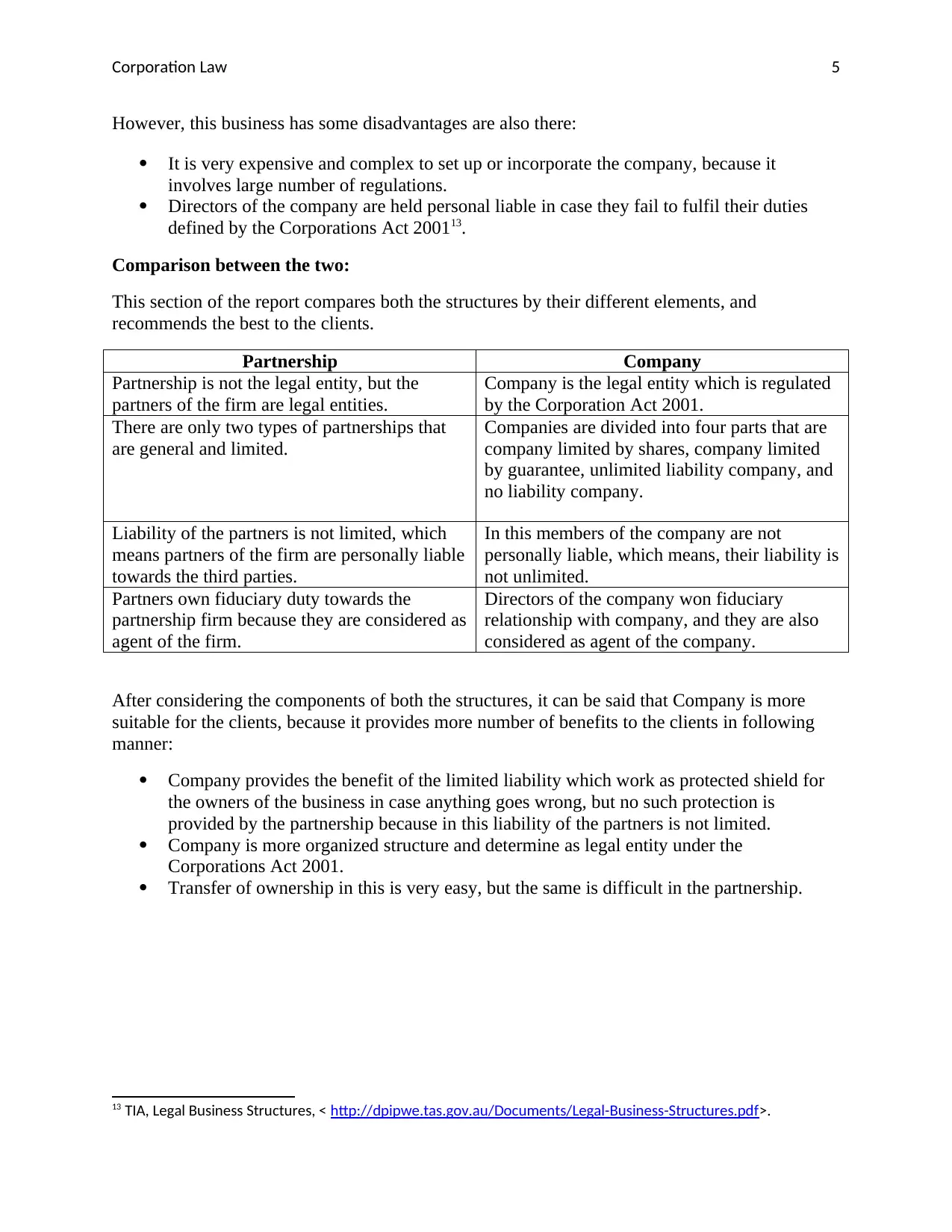
Corporation Law 5
However, this business has some disadvantages are also there:
It is very expensive and complex to set up or incorporate the company, because it
involves large number of regulations.
Directors of the company are held personal liable in case they fail to fulfil their duties
defined by the Corporations Act 200113.
Comparison between the two:
This section of the report compares both the structures by their different elements, and
recommends the best to the clients.
Partnership Company
Partnership is not the legal entity, but the
partners of the firm are legal entities.
Company is the legal entity which is regulated
by the Corporation Act 2001.
There are only two types of partnerships that
are general and limited.
Companies are divided into four parts that are
company limited by shares, company limited
by guarantee, unlimited liability company, and
no liability company.
Liability of the partners is not limited, which
means partners of the firm are personally liable
towards the third parties.
In this members of the company are not
personally liable, which means, their liability is
not unlimited.
Partners own fiduciary duty towards the
partnership firm because they are considered as
agent of the firm.
Directors of the company won fiduciary
relationship with company, and they are also
considered as agent of the company.
After considering the components of both the structures, it can be said that Company is more
suitable for the clients, because it provides more number of benefits to the clients in following
manner:
Company provides the benefit of the limited liability which work as protected shield for
the owners of the business in case anything goes wrong, but no such protection is
provided by the partnership because in this liability of the partners is not limited.
Company is more organized structure and determine as legal entity under the
Corporations Act 2001.
Transfer of ownership in this is very easy, but the same is difficult in the partnership.
13 TIA, Legal Business Structures, < http://dpipwe.tas.gov.au/Documents/Legal-Business-Structures.pdf>.
However, this business has some disadvantages are also there:
It is very expensive and complex to set up or incorporate the company, because it
involves large number of regulations.
Directors of the company are held personal liable in case they fail to fulfil their duties
defined by the Corporations Act 200113.
Comparison between the two:
This section of the report compares both the structures by their different elements, and
recommends the best to the clients.
Partnership Company
Partnership is not the legal entity, but the
partners of the firm are legal entities.
Company is the legal entity which is regulated
by the Corporation Act 2001.
There are only two types of partnerships that
are general and limited.
Companies are divided into four parts that are
company limited by shares, company limited
by guarantee, unlimited liability company, and
no liability company.
Liability of the partners is not limited, which
means partners of the firm are personally liable
towards the third parties.
In this members of the company are not
personally liable, which means, their liability is
not unlimited.
Partners own fiduciary duty towards the
partnership firm because they are considered as
agent of the firm.
Directors of the company won fiduciary
relationship with company, and they are also
considered as agent of the company.
After considering the components of both the structures, it can be said that Company is more
suitable for the clients, because it provides more number of benefits to the clients in following
manner:
Company provides the benefit of the limited liability which work as protected shield for
the owners of the business in case anything goes wrong, but no such protection is
provided by the partnership because in this liability of the partners is not limited.
Company is more organized structure and determine as legal entity under the
Corporations Act 2001.
Transfer of ownership in this is very easy, but the same is difficult in the partnership.
13 TIA, Legal Business Structures, < http://dpipwe.tas.gov.au/Documents/Legal-Business-Structures.pdf>.

Corporation Law 6
Part 3:
This report highlights the duties of directors under the Corporations Act 2001, and also states the
relevance of these duties in carrying on the business under the company structure. These duties
and its relevance are described through the ASIC v Adler (2002) 20 ACLC 576; 41 ACSR 7214.
This case is very unique and reflects the perfect example of the director’s responsibility towards
the shareholders and other stakeholders of the company.
Facts of this case involve the breach of number of provisions of the Corporations Act 2001, and
all these provisions deals with the duties imposed by Corporation Act 2on the directors of the
company. It must be noted that, collapse of HIH was happened because of the bad corporate
governance on part of the directors.
In case of ASIC v Adler, Santow J evaluates various statutory provisions in terms of determining
the duties owned by the directors of the company towards the company and shareholders.
Following are some important provisions of the Act which are defined by the Court in this case15:
Section 9 of the Corporation Act 200116 states the definition of the directors and other officers. In
terms of this section, Court held that persons who hold position of directors in HIH were also
determine as officer of their wholly own subsidiary. Court further states that, similar approach
was also adopted for Adler also even in situation when he was not appointed as director of the
subsidiary in proper manner.
Section 18017 of the Corporation Act 2001 states that directors of the company are under
obligation to conduct their action and fulfil their obligations with due care and diligence. This
responsibility is determined in terms of the obligations fulfilled by any reasonable person if such
person holds the similar position in the company. In the present case, Court held that, Williams
and Fodera fails to fulfil their duty under section 180 of the Act as both fails to fulfil their duty
with due care and diligence. William was the managing director of the HIH and also of HIHC,
but he fails to take measures of safety before allowing the HIHC to give loan to the PEE. In
context of Fodera, Court held that, Fodera was the finance director of the HIH, but she fails to
discuss the matter of giving loan to PEE with the board.
Clause 2 of this section provides the statutory defence of business judgment rule, but it was not
possible for both the directors to use this defence because they breach clause 1 of this section, as
they fail to use due care and diligence while performing their duties.
Section 18118 of the Act states that company’s directors are under obligation to conduct their
operations with good faith, for proper purpose, and in the company’s best interest. Court stated in
ASIC v Adler that this section was contravened by the Adler. Adler does not conduct its
operations in good faith, for proper purpose, and in the company’s interest. In this case, all
14 ASIC v Adler (2002) 20 ACLC 576; 41 ACSR 72.
15 Thommson reuters, Part 2D.1 – Duties and powers, < https://legal.thomsonreuters.com.au/browse/law-
annuals/pdf/corporations-legislation-2014-key-section-annotation-example-thomson-reuters.pdf>.
16 Corporation Act 2001- section 9.
17 Corporation Act 2001- section 180.
18 Corporation Act 2001- section 181.
Part 3:
This report highlights the duties of directors under the Corporations Act 2001, and also states the
relevance of these duties in carrying on the business under the company structure. These duties
and its relevance are described through the ASIC v Adler (2002) 20 ACLC 576; 41 ACSR 7214.
This case is very unique and reflects the perfect example of the director’s responsibility towards
the shareholders and other stakeholders of the company.
Facts of this case involve the breach of number of provisions of the Corporations Act 2001, and
all these provisions deals with the duties imposed by Corporation Act 2on the directors of the
company. It must be noted that, collapse of HIH was happened because of the bad corporate
governance on part of the directors.
In case of ASIC v Adler, Santow J evaluates various statutory provisions in terms of determining
the duties owned by the directors of the company towards the company and shareholders.
Following are some important provisions of the Act which are defined by the Court in this case15:
Section 9 of the Corporation Act 200116 states the definition of the directors and other officers. In
terms of this section, Court held that persons who hold position of directors in HIH were also
determine as officer of their wholly own subsidiary. Court further states that, similar approach
was also adopted for Adler also even in situation when he was not appointed as director of the
subsidiary in proper manner.
Section 18017 of the Corporation Act 2001 states that directors of the company are under
obligation to conduct their action and fulfil their obligations with due care and diligence. This
responsibility is determined in terms of the obligations fulfilled by any reasonable person if such
person holds the similar position in the company. In the present case, Court held that, Williams
and Fodera fails to fulfil their duty under section 180 of the Act as both fails to fulfil their duty
with due care and diligence. William was the managing director of the HIH and also of HIHC,
but he fails to take measures of safety before allowing the HIHC to give loan to the PEE. In
context of Fodera, Court held that, Fodera was the finance director of the HIH, but she fails to
discuss the matter of giving loan to PEE with the board.
Clause 2 of this section provides the statutory defence of business judgment rule, but it was not
possible for both the directors to use this defence because they breach clause 1 of this section, as
they fail to use due care and diligence while performing their duties.
Section 18118 of the Act states that company’s directors are under obligation to conduct their
operations with good faith, for proper purpose, and in the company’s best interest. Court stated in
ASIC v Adler that this section was contravened by the Adler. Adler does not conduct its
operations in good faith, for proper purpose, and in the company’s interest. In this case, all
14 ASIC v Adler (2002) 20 ACLC 576; 41 ACSR 72.
15 Thommson reuters, Part 2D.1 – Duties and powers, < https://legal.thomsonreuters.com.au/browse/law-
annuals/pdf/corporations-legislation-2014-key-section-annotation-example-thomson-reuters.pdf>.
16 Corporation Act 2001- section 9.
17 Corporation Act 2001- section 180.
18 Corporation Act 2001- section 181.
⊘ This is a preview!⊘
Do you want full access?
Subscribe today to unlock all pages.

Trusted by 1+ million students worldwide
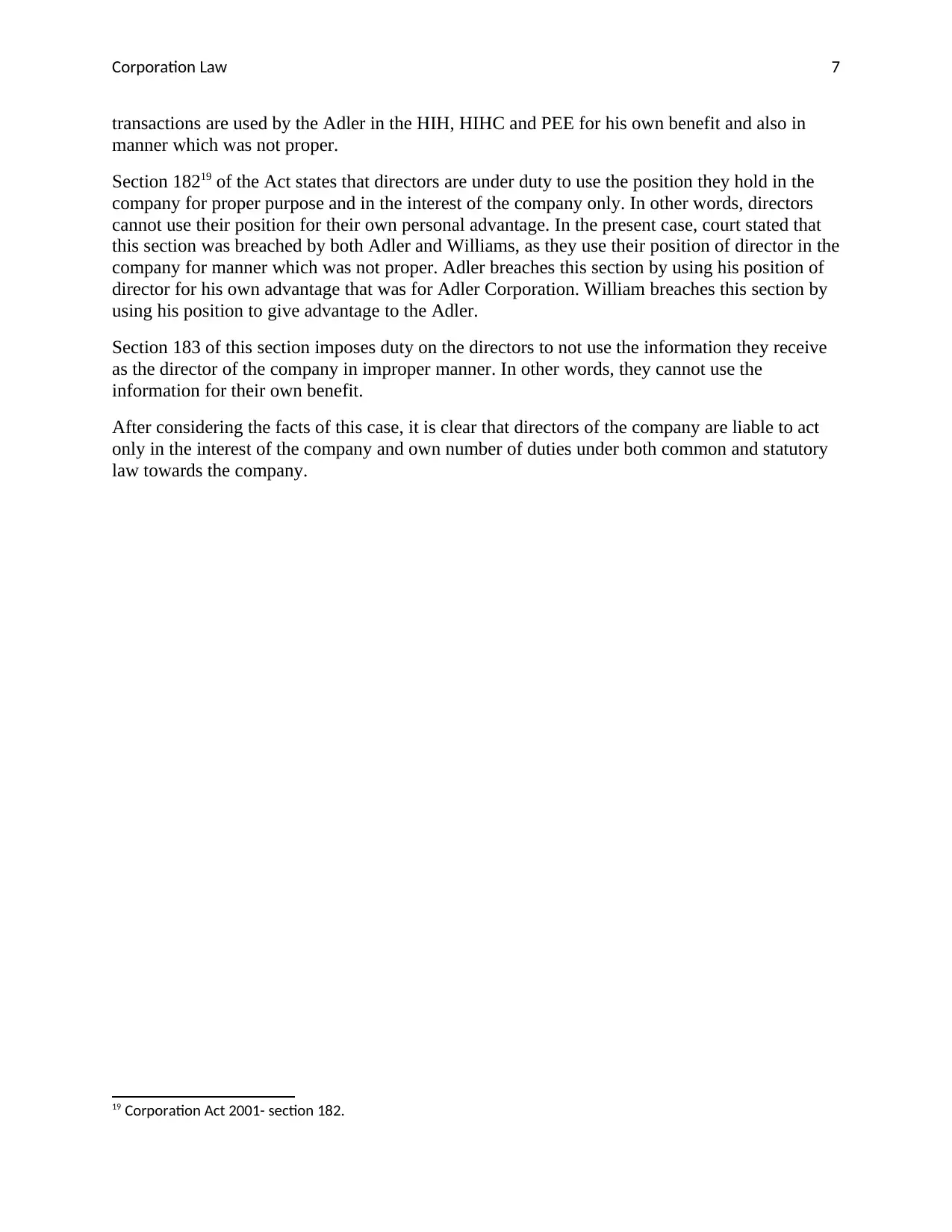
Corporation Law 7
transactions are used by the Adler in the HIH, HIHC and PEE for his own benefit and also in
manner which was not proper.
Section 18219 of the Act states that directors are under duty to use the position they hold in the
company for proper purpose and in the interest of the company only. In other words, directors
cannot use their position for their own personal advantage. In the present case, court stated that
this section was breached by both Adler and Williams, as they use their position of director in the
company for manner which was not proper. Adler breaches this section by using his position of
director for his own advantage that was for Adler Corporation. William breaches this section by
using his position to give advantage to the Adler.
Section 183 of this section imposes duty on the directors to not use the information they receive
as the director of the company in improper manner. In other words, they cannot use the
information for their own benefit.
After considering the facts of this case, it is clear that directors of the company are liable to act
only in the interest of the company and own number of duties under both common and statutory
law towards the company.
19 Corporation Act 2001- section 182.
transactions are used by the Adler in the HIH, HIHC and PEE for his own benefit and also in
manner which was not proper.
Section 18219 of the Act states that directors are under duty to use the position they hold in the
company for proper purpose and in the interest of the company only. In other words, directors
cannot use their position for their own personal advantage. In the present case, court stated that
this section was breached by both Adler and Williams, as they use their position of director in the
company for manner which was not proper. Adler breaches this section by using his position of
director for his own advantage that was for Adler Corporation. William breaches this section by
using his position to give advantage to the Adler.
Section 183 of this section imposes duty on the directors to not use the information they receive
as the director of the company in improper manner. In other words, they cannot use the
information for their own benefit.
After considering the facts of this case, it is clear that directors of the company are liable to act
only in the interest of the company and own number of duties under both common and statutory
law towards the company.
19 Corporation Act 2001- section 182.
Paraphrase This Document
Need a fresh take? Get an instant paraphrase of this document with our AI Paraphraser
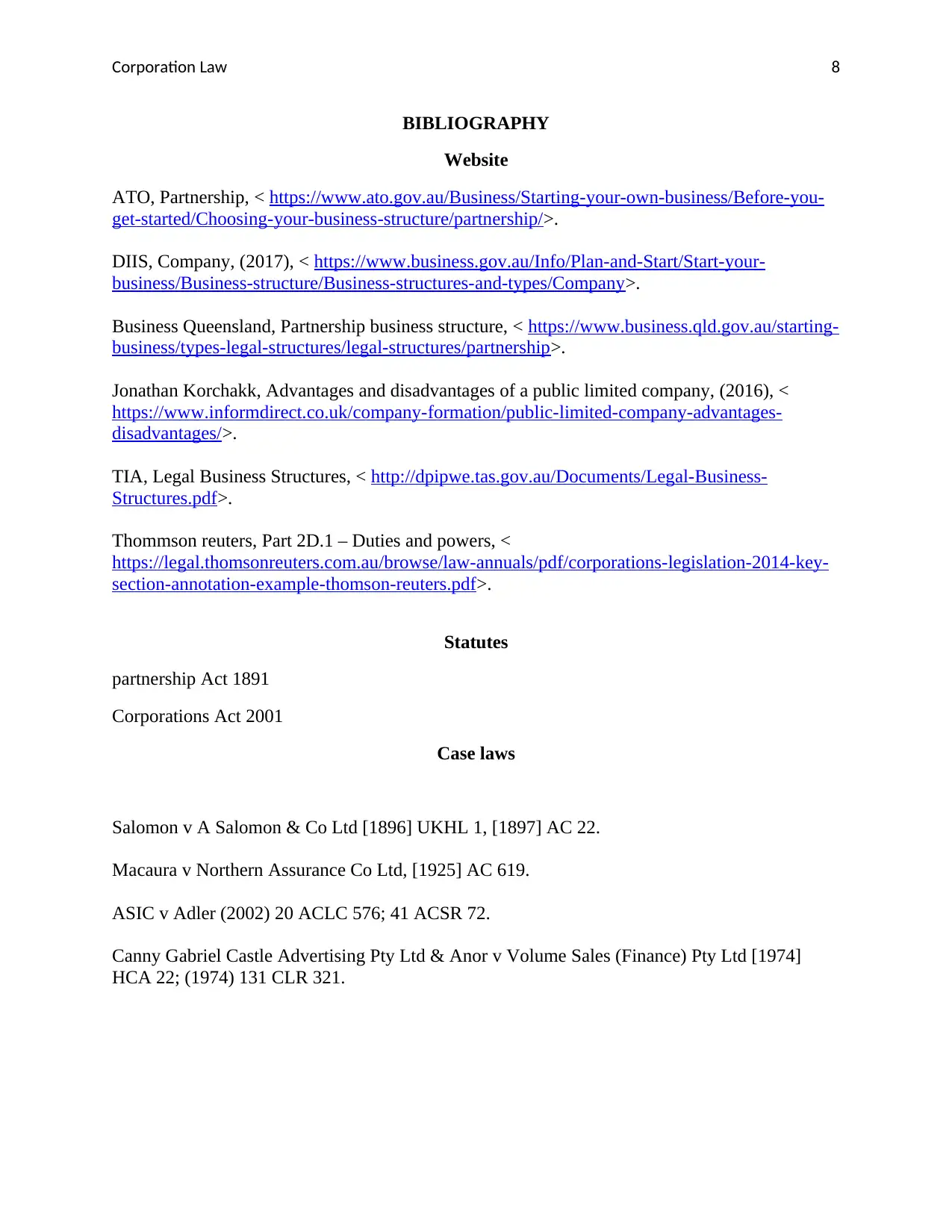
Corporation Law 8
BIBLIOGRAPHY
Website
ATO, Partnership, < https://www.ato.gov.au/Business/Starting-your-own-business/Before-you-
get-started/Choosing-your-business-structure/partnership/>.
DIIS, Company, (2017), < https://www.business.gov.au/Info/Plan-and-Start/Start-your-
business/Business-structure/Business-structures-and-types/Company>.
Business Queensland, Partnership business structure, < https://www.business.qld.gov.au/starting-
business/types-legal-structures/legal-structures/partnership>.
Jonathan Korchakk, Advantages and disadvantages of a public limited company, (2016), <
https://www.informdirect.co.uk/company-formation/public-limited-company-advantages-
disadvantages/>.
TIA, Legal Business Structures, < http://dpipwe.tas.gov.au/Documents/Legal-Business-
Structures.pdf>.
Thommson reuters, Part 2D.1 – Duties and powers, <
https://legal.thomsonreuters.com.au/browse/law-annuals/pdf/corporations-legislation-2014-key-
section-annotation-example-thomson-reuters.pdf>.
Statutes
partnership Act 1891
Corporations Act 2001
Case laws
Salomon v A Salomon & Co Ltd [1896] UKHL 1, [1897] AC 22.
Macaura v Northern Assurance Co Ltd, [1925] AC 619.
ASIC v Adler (2002) 20 ACLC 576; 41 ACSR 72.
Canny Gabriel Castle Advertising Pty Ltd & Anor v Volume Sales (Finance) Pty Ltd [1974]
HCA 22; (1974) 131 CLR 321.
BIBLIOGRAPHY
Website
ATO, Partnership, < https://www.ato.gov.au/Business/Starting-your-own-business/Before-you-
get-started/Choosing-your-business-structure/partnership/>.
DIIS, Company, (2017), < https://www.business.gov.au/Info/Plan-and-Start/Start-your-
business/Business-structure/Business-structures-and-types/Company>.
Business Queensland, Partnership business structure, < https://www.business.qld.gov.au/starting-
business/types-legal-structures/legal-structures/partnership>.
Jonathan Korchakk, Advantages and disadvantages of a public limited company, (2016), <
https://www.informdirect.co.uk/company-formation/public-limited-company-advantages-
disadvantages/>.
TIA, Legal Business Structures, < http://dpipwe.tas.gov.au/Documents/Legal-Business-
Structures.pdf>.
Thommson reuters, Part 2D.1 – Duties and powers, <
https://legal.thomsonreuters.com.au/browse/law-annuals/pdf/corporations-legislation-2014-key-
section-annotation-example-thomson-reuters.pdf>.
Statutes
partnership Act 1891
Corporations Act 2001
Case laws
Salomon v A Salomon & Co Ltd [1896] UKHL 1, [1897] AC 22.
Macaura v Northern Assurance Co Ltd, [1925] AC 619.
ASIC v Adler (2002) 20 ACLC 576; 41 ACSR 72.
Canny Gabriel Castle Advertising Pty Ltd & Anor v Volume Sales (Finance) Pty Ltd [1974]
HCA 22; (1974) 131 CLR 321.
1 out of 8
Related Documents
Your All-in-One AI-Powered Toolkit for Academic Success.
+13062052269
info@desklib.com
Available 24*7 on WhatsApp / Email
![[object Object]](/_next/static/media/star-bottom.7253800d.svg)
Unlock your academic potential
Copyright © 2020–2026 A2Z Services. All Rights Reserved. Developed and managed by ZUCOL.





